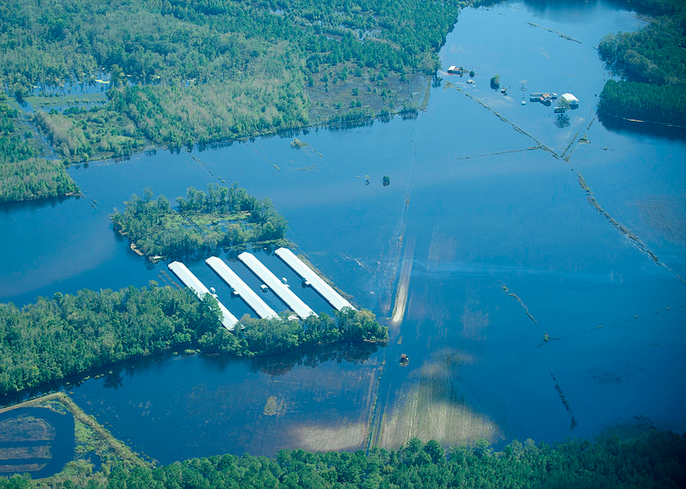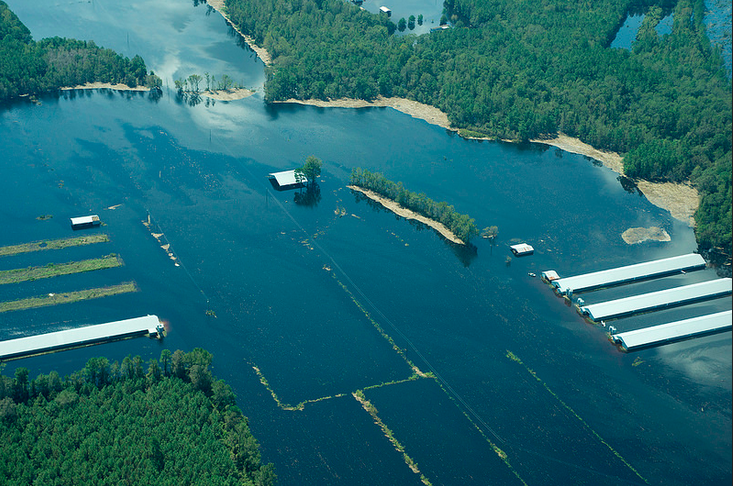Hog Hell: The Truth About NC's Pork Industry
- Mickey Snowdon
- Mar 4, 2019
- 4 min read
Risky Business
There are nearly as many pigs in North Carolina as there are people. North Carolina is the second-largest pork producer in the country (the industry contributes over 2.5 billion dollars to the state's economy), and Sampson County in the eastern part of the state has the most confined animal feeding operations, or CAFOs, for hogs in the nation.
All these pigs defecate and urinate a lot, and it all has to go somewhere.
That “somewhere” consists of huge excrement holding reservoirs called “lagoons”. Hog lagoons run 30 feet deep in Sampson County, which is dangerously close to the region’s water table.
A hog waste lagoon in Beafort, NC. The pink color is the result of bacteria feeding on waste. Photo courtesy of Flickr Creative Commons.
Pacific Standard Magazine writer, Emily Moon, explains that these lagoons also contain a toxic slew of still-born pig fetuses, afterbirth, blood and pesticides that, when mixed, turn the reservoirs bright pink (the result of bacteria feeding on the waste). A study by Duke University found that if ingested, the waste from hog lagoons can cause all types of infectious diseases, and has been linked to birth defects and cancer.
What's at Stake?
Of course, no one willingly intends to consume this hazardous soup, but most of the hog farms in North Carolina lie within a major floodplain that drains into the Neuse and Cape Fear Rivers.
Combined, these rivers supply over four million North Carolinians with drinking water, and they produce 90 percent of the state's seafood. North Carolina's seafood industry is worth over 1.7 billion dollars.
A map of hog farms along the Neuse and Cape Fear Rivers floodplain. Photo courtesy of Michael Biesecker, AP.
The problem is, the Neuse and Cape Fear Rivers were rated the seventh-most endangered rivers in the U.S. in 2017 by the river advocacy organization, American Rivers, due to agricultural waste pollution. Hog waste makes up most of that pollution.
According to the 2017 report by American Rivers, “This waste contains bacteria, pathogens, concentrated levels of nutrient pollution and residual antibiotics that if released into nearby rivers and streams would cause significant contamination.”
Blood in the Water
Contamination from these waste lagoons is inevitable, as they are completely uncovered and low-lying.
In 1999, Moon says that Hurricane Floyd killed two million chickens and turkeys and 110,000 hogs. They drowned in their own excrement from flooded lagoons. Local counties were affected by the flow of animal feces, urine and carcasses, creating a major health risk.
Afterwards, North Carolina passed a law banning the creation of new lagoons and the expansion of existing ones, but in 2016, the eastern part of the state experienced the same problem again when Hurricane Matthew hit. Over 15 CAFO lagoons emptied their contents into the floodwaters, which infiltrated public waterways.
As of 2017, American Rivers reported that these CAFOs have not been moved.
Photos courtesy of Alan Cradick.
After Matthew, one would think the state had learned its lesson, but on September 14th, 2018, Hurricane Florence made landfall on North Carolina’s coast. By the 19th, Cape Fear River Watch, a nonprofit organization dedicated to protecting the Cape Fear River Basin, reported that numerous hog waste lagoons had been inundated by the storm and had released their contents into the South and Cape Fear Rivers.
Why doesn't North Carolina learn its lesson? It seems like a no-brainer that you shouldn’t build massive holding ponds of hog waste in a floodplain, but Moon explains that the reasons are due to “ineffective regulation, an increasingly industry-friendly state legislature, entrenched monopolies, and, of course, geography.”
Collaboration and Innovation
The most obvious solution to North Carolina's swine pollution is to move the state’s CAFOs out of the floodplain, but that would be costly and would require the support of both the North Carolina Department of Environmental Quality and the North Carolina Department of Agriculture, and these departments aren't keen on hampering the pork industry's crucial economic contribution.
One company has ventured to solve at least part of the problem. According to an article in National Hog Farmer Magazine by author Joe Vansickle, a product called BionSoil, produced by Bion Technology, converts hog waste into a soil-like fertilizer that can be applied to gardens, golf courses, nurseries, and more.
The company Bion Technology is taking aim at cleaning up livestock waste. Photo courtesy of Bion Technology.
And what about the lagoons? According to Vansickle, "The manure nutrient management system in use...utilizes a series of ponds to stabilize odor-causing compounds." The author goes on to describe Bion's extensive effluent treatment process used for treating swine waste, although he admits that using BionSoil necessitates higher irrigation levels in order to dilute the large amount of nitrogen present in the waste.
Christian Breen, a representative of Waterkeeper Alliance, a nonprofit organization focused on preserving and protecting water, thinks the solution should start with the companies who own the CAFOs. According to Breen, these companies should shut down their existing lagoons and invest in on-site water treatment to handle the billions of gallons of waste produced each year.
Whether utilizing new technologies to manage hog waste and/or tightening up regulations around CAFOs, it's clear that North Carolina's current system demands a makeover.
Bonus Material
Still curious about hog waste in North Carolina? Check out this interactive map of CAFOs created by the Environmental Working Group, a nonprofit dedicated to human and environmental health, and Waterkeeper Alliance.











Comments